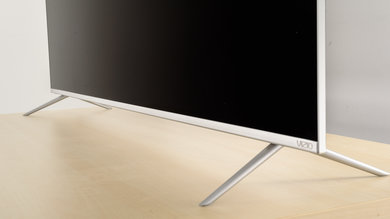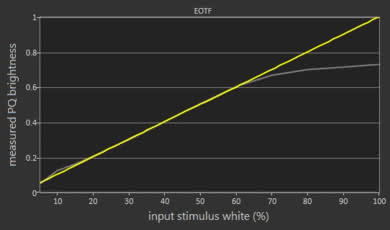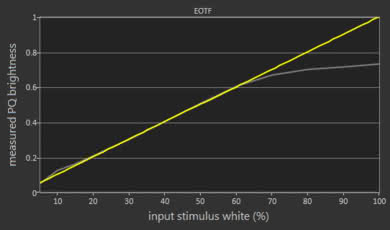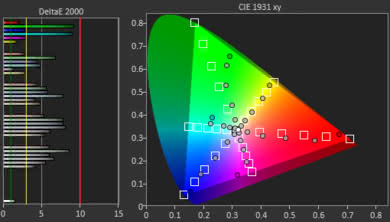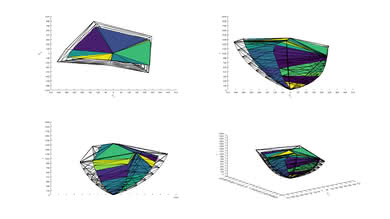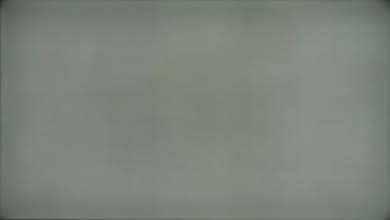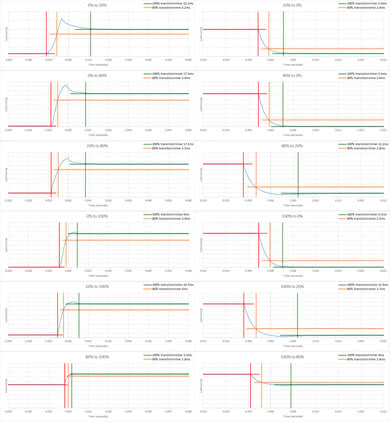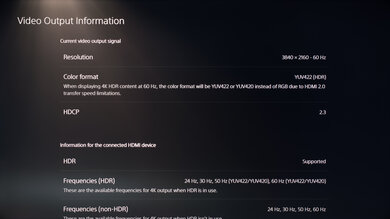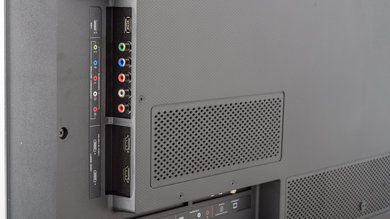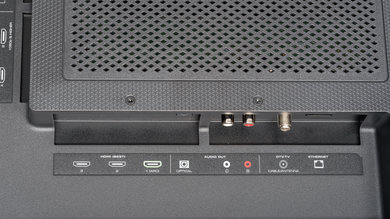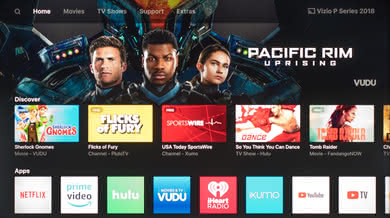Our Verdict
The Vizio P Series is a great TV for almost any kind of usage. Its low input lag, fast response time, great contrast ratio, good uniformity and great color accuracy make it a great choice for almost any audience.
- Great dark scene performance
- Excellent motion handling
- Low input lag
- Image degrades when viewed at an angle
Great movie performance for the Vizio P65-F1. Blacks are deep and local dimming works well to improve contrast ratio in dark scenes. The TV has a good overall picture quality with uniform blacks and accurate out-of-the-box colors. It will keep happy those who view 1080p content like blu-ray.
The Vizio P Series 2018 is good for watching TV in a bright room. The TV can get bright and can overcome most glare. It has great reflection handling, but the picture quality degrades rapidly when viewed at an angle, which is bad for wide rooms. The TV does an ok job at upscaling cable content, but you might notice some clouding.
A good TV for watching Sports. Fast response time, good reflection handling and great SDR peak brightness make this TV suitable for watching fast moving content in a bright, but not wide room due to poor viewing angles. Depending on the panel some people might notice some clouding due to decent gray uniformity, especially in panning shots.
The Vizio P65-F1 is an excellent TV for playing video games. The low input lag and the very fast response time guarantee a nice gaming experience. The TV is capable of supporting various resolutions and have great interpolation image clearing features, that will keep gamers happy.
This is a good TV for watching HDR movies. It has deep blacks and great black uniformity. In HDR content, details look bright with saturated colors that will keep most people happy.
The Visio P series 2018 is a great TV for HDR gaming. Its excellent response time, wide color gamut, good contrast ratio and 4K @ 60Hz with HDR display capabilities, make it a good choice for those who want to use it for HDR gaming.
This a good TV for use as a PC monitor. It has very low input lag and you will be pleased with the TVs reaction time. The response time is very low and you will not notice any blur. However, if you sit too close to the TV the edges might look a little dim and colors might be off due to poor viewing angles.
Changelog
- Updated Mar 09, 2021: Converted to Test Bench 1.6.
- Updated May 21, 2020: Converted to Test Bench 1.5.
- Updated Feb 21, 2020: Converted to Test Bench 1.4.
- Updated May 17, 2019: There is an issue with the latest P Series Firmware affecting audio output on HDMI 5. We recommend against installing it at this time. Our full comment is available here, and there is a discussion open about it here
Check Price
Differences Between Sizes And Variants
We tested the 65" (P65-F1). With the exception of the local dimming performance, for the most part we expect our review to be valid for the 75" (P75-F1) and the 55" (P55-F1) variant of the Vizio P Series 2018. Due to the difference in the number of local dimming zones between the different sizes, there is probably a difference in local dimming performance, but we don't know how the other sizes perform.
| Size | Model | LCD Type | Clear Action | Real Refresh Rate | Local Dimming Zones |
| 55" | P55-F1 | VA | 720 | 120 Hz | 56 |
| 65" | P65-F1 | VA | 720 | 120 Hz | 100 |
| 75" | P75-F1 | VA | 720 | 120 Hz | 120 |
Update 12/04/2018: We have received a few reports that the 55" P Series uses a different sub-pixel structure, and this may be noticeable when using it as a PC. There is an open discussion on this here.
Popular TV Comparisons
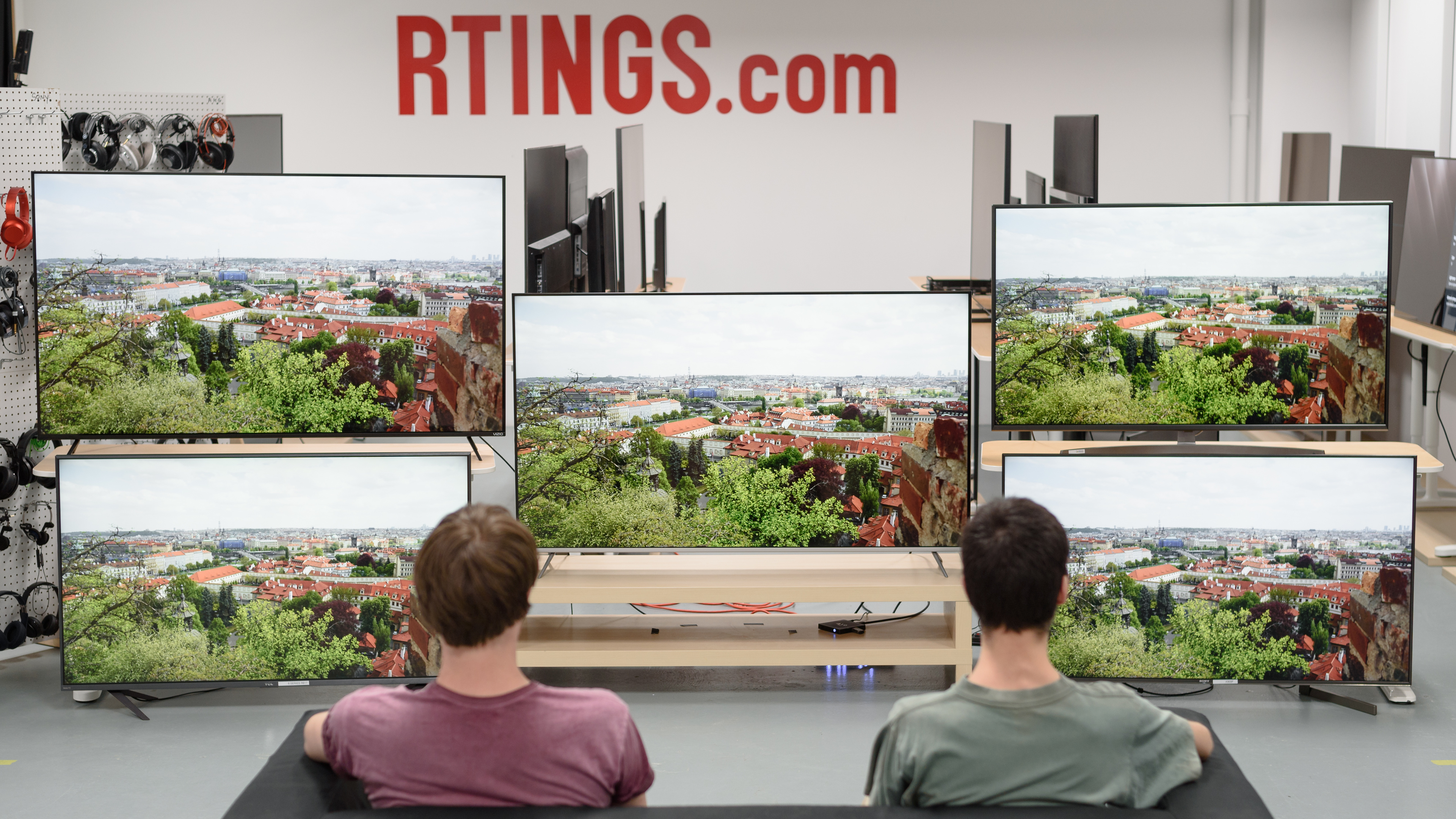
The Vizio P-Series 2018 is a very good mid-range 4k TV. It is a good improvement over the 2017 P-Series and performs very well compared to the competition. See our recommendations for the best 4k TVs and the best TVs.
The Vizio P Series 2018 is better than the Vizio P Series 2017 in almost every use. The P Series 2018 has lower input lag, which is great if you play video games or HDR games. It also has better reflection handling so you can place it in a room with many light sources without any issue. Finally, the Vizio P Series 2018 has a faster response time, thus you will notice only a small blur trail in the image when you watch fast action sports.
The Vizio P Series 2018 is much better than the TCL C807. The Vizio P Series has better dark room performance thanks to the full array local dimming feature and much better black uniformity with less clouding. The P Series 2018 has better motion handling; it has a faster response time that produces less motion blur, and it can interpolate lower frame rate content up to 120 Hz. The P Series 2018 also has a better black frame insertion feature that can further improve motion clarity.
The Sony X900F is slightly better than the Vizio P Series 2018. The X900F performs better in a bright room thanks to the better anti-reflective coating, and it's brighter and better able to overcome glare. The X900F also has wider viewing angles and has a more robust smart platform. The Vizio P Series 2018 has lower input lag for gaming or for use as a monitor. The P Series also has a more advanced black frame insertion feature and a better local dimming feature.
The Vizio P Series 2018 is better than the Samsung NU8000. The Vizio P Series has a more advanced full-array local dimming system that produces better blacks and delivers better dark room performance, as well as helping highlights to stand out in HDR. The P Series has smoother motion, since the response time is much faster, great for gaming or fast action scenes. The Samsung NU8000 has some gaming-oriented features, including VRR and automatic game mode.
Test Results
The design of the Vizio P Series 2018 is very good. The stand is metallic and resembles last years, but the legs have a more round finish. It is very wide and so you will need a wide table to fit this TV. If wall mounted, the inputs are easily accessible. The borders are metallic and the TV has a premium feel. The build quality is also very good and will keep most people happy.
The back of the TV is plastic. There is no cable management, however, the inputs are close to the edge and are easy to access if the TV is wall mounted.
The SDR peak brightness is very good. The brightness of the TV is higher on smaller window sizes so highlights on darker scenes will appear bright. It is slightly better than the P Series 2017 for small windows, as it boosts their brightness rather than dimming them.
All this brightness testing was done in the Calibrated Dark picture mode, because it has the best picture quality. In the Vivid picture mode, the TV can reach a peak brightness of 968 cd/m² for a short time.
Update 08/27/2018: The SDR peak brightness has been retested with the latest firmware (1.0.18.4) and it remains in the same ballpark.
The 2018 P-Series has good local dimming. The 65" model we tested is a FALD panel with 100 local dimming zones that perform quite a good job in dimming the blacks and enhancing the contrast. There is very little clouding as the algorithm is very aggressive. This results in somewhat dimmer whites but without sacrificing detail.
The 55" model (Vizio P55-F1) has only 56 local dimming zones whereas the 75" (Vizio P75-F1) has 120. These variations might have an impact on the local dimming effectiveness of these models.
Update 01/02/2019: The name for Vizio's local dimming feature has been renamed from Xtreme Black Engine Pro to Active Full Array.
Update 03/21/2019: We have been contacted by readers who have had issues with pulsing local dimming in some scenes on this TV (see this discussion thread. Please let us know in the discussions if you also experience this problem.
The HDR peak brightness is good and a definite improvement from last years' model. In dark HDR scenes, the TV displays small bright details well, but still falls short of the brightness level achieved by the Sony X900F and the TCL R617.
Update 08/27/2018: The HDR peak brightness has been retested with the latest firmware (1.0.18.4) and it remains in the same ballpark.
The gray uniformity of this Vizio P series 2018 is decent. It is a slight improvement from the P Series 2017, but some clouding will be visible especially in panning shots and this might annoy sports fans.
In darker scenes (5% gray) things are slightly better but you might still be able to spot minor clouding.
Update 07/27/2018: The gray uniformity of TVs varies between units, and we have received reports of bad uniformity on some Vizio P Series TVs. We don't know how widespread this issue us, but will update the review as we learn more.
The viewing angles of the P65-F1 is bad. This is typical for a VA panel where as soon as there is an increase in viewing angle, blacks turn gray, then the colors shift and finally, brightness diminishes. This TV is not your best option if viewing angle is of importance.
Reflection handling is very good. A great improvement from the 2017 P Series.
Just like the M Series 2018, the semi-gloss filter helps diffuse direct reflections and glare even in bright environments. However, some people will notice some direct reflections, but most people won't be bothered.
The out-of-the-box color accuracy of the P series 2018 is remarkable and this is a big improvement from last years model.
The best results were obtained with the Picture mode set to Calibrated Dark and both the white balance dE and the color dE are below 3. At these values most people will not notice any imperfections. The colors were a little warm and the overall TV shows a slightly higher gamma than our target of 2.2, so the image is slightly dark.
Colors and shadows of the Vizio P65-F1 after calibration are outstanding. The already great accuracy becomes almost perfect in all aspects of our measurements. Color dE and white balance dE are very small, whereas the gamma curve is followed perfectly at 2.2. Finally, the color temperature is almost perfect
Note: Calibration can be performed very easily with the help of the Smartcast app, as no on-screen menu is necessary.
You can see our recommended settings here.
Upscaling of low-quality content such as DVDs is a bit more blocky, and there is more noise, similar to the P Series 2017. This is visible when viewing DVDs.
The upscaling performance is very similar to performance the M Series 2017
Native 4k content such as UHD Blu-rays or high-quality streaming content is displayed without any issues.
Update 12/04/2018: We have received a few reports that the 55" P Series uses a different sub-pixel structure, and this may be noticeable when using it as a PC. There is an open discussion on this here.
This Vizio P series 2018 has a good wide color gamut. It is a slight improvement from the 2017 model. And up to par with the Sony X900F.
The HDR EOTF in Calibrated Dark with Backlight at 50 follows the target PQ quite well. If you find HDR content too dark you can raise the Backlight to 100 to raise the EOTF. This will have a result of almost everything being brighter, as shown in this plot.
Enabling the Game Low Latency setting while gaming does not affect the game EOTF. The default EOTF in the Computer Picture mode a.k.a. PC mode overshoots the target PQ curve a bit, but when the Gamma setting is set to 2.2, like it is in Calibrated Dark, the EOTF becomes identical to that of Calibrated Dark.
The Vizio P Series 65 has decent color volume. In the P3 volume, it covers the gamut well; a slight improvement from last year's model. In both color volumes, the darker colors are not displayed very well, and blues can't get very bright.
The Vizio P65-F1 has decent gradient. There is small banding almost everywhere, medium banding in dark green and grey, but no major banding at all. 8-bit banding is not visible since this is a 10-bit panel. The performance is slightly worse than the Vizio P Series 2017.
There is no gradient smoothing feature, but the Reduce Noise feature may reduce banding in low-quality content, at the cost of some loss of fine details.
We don't expect VA panels to experience permanent image retention, as the VA panel in our long-term test appears immune.
Update 07/30/2019: The P Series has received an update that changes the backlight flicker to 120Hz. The picture and score have been updated to reflect the change.
The P series uses PWM and amplitude to dim its backlight. It flickers at 960Hz. This frequency is so fast that almost no-one can notice it. It is only flicker-free when the backlight level is set at maximum (100).
This does produce motion with less noticeable duplications than last year's P Series 2017 or the TCL 6 Series R617.
The BFI mode on the P Series 2018 is activated by setting Clear Motion to On. Just like the M-Series 2018, when BFI is enabled the perceived screen brightness is not reduced. This is because the brightness spikes higher than before to compensate for the off cycles.
The 2018 P series motion interpolation is excellent. The TV can interpolate both 30fps content and 60fps content up to 120 Hz. To do that, you must set the Reduce judder to interpolate 30Hz content, and set the Reduce Motion Blur to interpolate 60Hz content.
Motion interpolation stops when there's too much motion, and there are some visible artifacts when interpolating. Interpolation is nearly perfect during slow moving shots
This Vizio P65-F1 is decent at being stutter free. There will be some stutter on slow fps content, because of the very fast response time of this TV. Most people will not notice it, but if you find that it bothers you, you can enable motion interpolation to reduce it.
The TV has an option to remove judder. This only works if the signal is 24p or if it comes through a Native App. When a 24p signal is coming through a 60p or a 60i source (like a cable box), the TV's option to remove judder does not work. In this case, to remove judder you must enable motion interpolation with a very low setting, so as to avoid potential artifacts.
The Vizio P65-F1 does not support VRR.
Update 05/17/2019: There is an issue with firmware version 2.1.7.1. When on HDMI 5 with 'Game Mode' enabled, there is no sound. Our model did not see this update automatically, so it is possible that it is either a gradual roll-out, or that Vizio has stopped rolling it out. If you are prompted to update to 2.1.7.1, we recommend against installing it.
Just like the P Series 2017, this year's model has excellent low input lag for SDR content. However, this year's model also has great input lag for HDR content as well.
HDMI port 5 is a low bandwidth port that doesn't support HDR, but has much lower input lag than the other ports, making it excellent for SDR gaming. Again we conducted all tests on HDMI ports 1, 2 and 5: ports 1 and 2 have similar input lags, but port 5 has much lower lag for all resolutions that it can support, including 4k @ 60 Hz @ 4:2:0.
Chroma 4:4:4 only shown properly in Computer mode.
| Test | HDMI 1 | 2 | 5 |
| 1080p @ 60 Hz | 27.0 | 26.6 | 15.3 |
| + HDR | 27.3 | 26.6 | N/A |
| out of game mode | 145.4 | 145.3 | 90.3 |
| 1080p @ 120 Hz | 30.0 | 29.9 | 10.5 |
| 4k @ 60 Hz | 27.2 | 26.8 | 15.3 |
| + HDR | 27.3 | 26.9 | N/A |
| + 4:4:4 | 26.8 | 26.9 | N/A |
| + 4:4:4 + 8 bit HDR | 26.8 | 26.9 | N/A |
| out of game mode | 143.8 | 143.5 | 90.3 |
| with interpolation | 137.9 | 137.1 | 83.9 |
All of the most common resolutions are supported on HDMI ports 1-4, and most on port 5.
HDMI Port 5 supports a 4k @ 60 Hz input, but only at 4:2:0. It does not support 4:2:2 or 4:4:4 because it does not have the necessary bandwidth. It also doesn't support HDR.
Ports 1-4 support all common formats including chroma 4:4:4 and 4:2:2, but only when 'Full UHD Color' is enabled for the port being used.
4:4:4 color is only shown properly when the TV is set to Computer mode. Sharpness at 0 means no added sharpness. It is automatically greyed out in Computer mode.
Update 07/31/2018: We have received reports that there are issues with sending a 4k HDR signal from a game console including the Xbox One X and PS4 Pro. These issues appear to be isolated and we have been unable to reproduce the problem.
Update 12/04/2018: We have received a few reports that the 55" P Series uses a different sub-pixel structure, and this may be noticeable when using it as a PC. There is an open discussion on this here.
Update 11/14/2019: Vizio has added support for HDR10+ on many 2019 and 2018 models. Unfortunately, we no longer have the 2018 models, so we're unable to confirm if they support HDR10+.
4k @ 60Hz @ 4:4:4 HDR works for all ports except HDMI 5.
Just like the M Series 2018, the P Series 2018 has dedicated ports for a shared component and composite input.
The rear inputs include an 'analog audio out' for use with wireless headphones without the need for an adaptor. Also, a 'Cable/Antenna' input is present for the TV tuner that returns with this year's model.
To get the optical DTS to work we had manually switch to bitstream, as with the auto setting the signal would stay in PCM. CEC is needed for ARC passthrough (setting name: CEC).
The frequency response is sub-par. LFE (low-frequency extension) is at 120Hz, meaning this TV doesn't produce any thump or rumble, and doesn't have much punch or body to its bass either. The response above the LFE point is not very even either and lacks a bit of detail, which is not ideal for producing dialogs, especially at higher volumes. Additionally, it doesn't have a room correction system either, that's why it wasn't able to remove the modes of test room around 200Hz. On the upside, it reached 87.2dB SPL at maximum volume, which is above average.
The distortion performance is about average. The overall amount of THD produced is elevated, especially between 1KHz and 2KHz, which could make the sound of that region a bit harsh. On the upside, there is not a big jump in THD at maximum volumes.
The interface of the P65-F1 is decent. It is slow and basic, there are no animations and the apps load slowly. The TV shows and movies tabs are noticeably laggy. The TV slows down to a trickle for half a second then speeds through the next movies.
Update 10/04/2018: We have received some reports of lagging or freezing when changing inputs, which appears to be a bug related to the 'CEC' option and compatibility with certain devices. We haven't been able to recreate this issue with our Yamaha RX-V379.
The TV's interface does not have ads. There is a scrolling banner in the main app page for suggested content that can not be disabled and can bother some people.
The Vizio P65-F1, just like the M series 2018, comes with 18 preloaded apps:
Netflix, Prime Video, Crackle, VUDU, iHeart Radio, YouTube, Newsy, Dove channel, Curiosity stream, Con TV, Pluto TV, Haystack TV, Xumo, Plex, Fandango Now, NBC, YouTube TV and Hulu.
Unfortunately, there is no app store to download more, but the TV does support Google Casting though.Update 06/19/2018: 3 preloaded apps were missing from the app list. They have been added to the review.
Update 07/31/2018: Support for 4K HDR streaming on Amazon Video has been added with firmware version 1.0.18.4. The review has been updated.
Update 11/15/2018: Vizio has added a 'WatchFree' input via a firmware update. This uses the free Pluto TV service on the backend, and is well integrated.
The remote control is lightweight with small buttons. There are 6 button shortcuts for Vudu, Netflix, Amazon Video, Xumo, Crackle and iHeart radio.
There is no voice control built into the remote or on the TV, but you can connect a Google Home or Amazon Alexa device if you have one.


